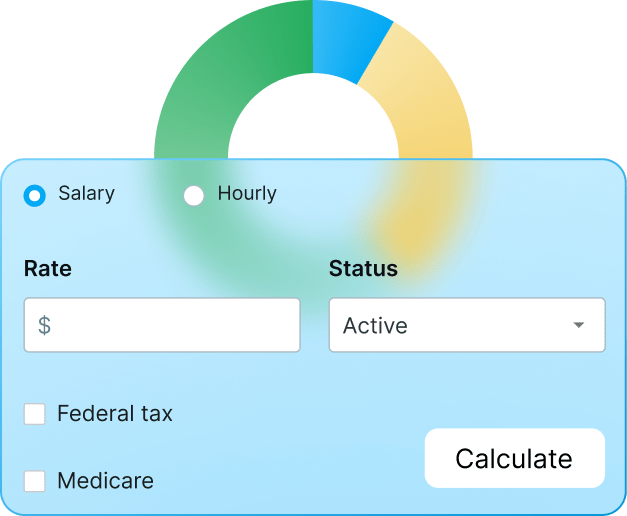Whether you’re an accounting firm, part of a remote bookkeeping team, or managing multiple clients at a company — knowing where your time goes is essential.
With all the moving parts in bookkeeping (calls, meetings, client hopping, paperwork, and everything in between), it’s easy to feel scattered or overworked. Not to mention the potential client disputes over invoicing.
That’s why time tracking isn’t just helpful — it’s a must.
Let’s see how to track time for bookkeeping, improve workflow, and stay profitable along the way.

Table of Contents
Why time tracking matters in bookkeeping
Time tracking gives you valuable, actionable data — and data drives better decisions.
After all, you’re not just balancing books. You’re managing client emails, calls, reports, urgent requests, and let’s not forget the occasional chaos. Without time tracking for bookkeeping, it’s almost impossible to:
- Bill clients accurately,
- Understand where your time actually goes,
- Improve your workflows and prevent burnout, or
- Scale your business with confidence.
When you have your data from time tracking, you can use it to generate clean, detailed reports for clients or your team, showing exactly how time was spent.
In the long run, this data can help you identify patterns, refine pricing, and allocate resources more efficiently.
As Tamara Stefanović, Director of Financial Operations at CAKE.com, told us, time tracking software is a handy tool in the modern business environment:

“As someone who leads a Finance team, I believe that the implementation of time tracking software is of particular importance, and we use it every day. The nature of the work my team does implies an extremely high level of responsibility, dedication, and analytically oriented employee profiles.”
According to Tamara, market expansion and numerous other factors influence the need for an adequate tool that will realistically display time spent at work, properly measure performance, and be a benchmark of commitment to the work process:

“What contributes to this type of systematicity, conciseness, and good organization is, among other things, time tracking software that transparently indicates the time spent on a specific task, part of the work process, and the process itself as a whole.”
💡 CLOCKIFY PRO TIP
For more information on why using a time tracker and timesheet at work can be beneficial, check out this article:
Benefits of time tracking for bookkeeping
One study on time management and performance in organizations states that time tracking for bookkeepers, as an integral part of organizational structure, has numerous benefits.
Let’s explore a few.
#1: Improved job performance and decision making
When people manage their time well, they stay focused, complete tasks more efficiently, and make fewer mistakes — leading to better job results.
Also, time tracking gives managers and employees clear data. This helps with making better decisions, task delegation, and adequate employee performance evaluation based on real insights.
As David Hern, founder of a financial and valuation services company, explains, learning more about each job cost is one of the greatest advantages of time tracking for bookkeeping:

“One of the biggest benefits is job costing. Time tracking helps us analyze which projects are profitable and which ones are eating margin. Without that insight, how can you improve or grow strategically?”
#2: Boosted productivity and skill growth
Bookkeeping time tracking helps identify where time is spent and wasted. This allows individual accountants and teams to work smarter (not longer) and get things done with the same effort.
Furthermore, time management helps workers self-organize and take control of their tasks. Over time, this builds discipline and confidence — valuable skills in any role, but especially accounting.
Improve productivity with Clockify
#3: Better planning and prioritization
By understanding how long tasks really take, teams can set more realistic deadlines, reduce last-minute rushes, and prevent overcommitment.
When you combine bookkeeping and time management properly, you learn to separate urgent tasks from truly important ones, leading to more meaningful work and more satisfied clients.
Furthermore, Jackie Shaw, a co-founder of a bookkeeping company, tells us that having an electronic time tracking system is well worth it, especially one that imports into your accounting software:

“That way, it’s easy to create time and material invoices for clients. It also allows you to run reports on the quantity of time spent versus what you expected for the fixed price contracts. This helps you stay on top of profitability and notice any scope creep before it becomes a problem.”
#4: More accountability, less stress, and zero burnout
Tracking time makes work more transparent. Everyone knows what’s expected and how time is being used — which creates a culture of responsibility and trust.
With a well-structured day, you feel in control of your workload, while stress levels drop and job satisfaction increases. Gen Z employees especially value structure that helps reduce mental health strain, as evident from this research about how time management affects job satisfaction.
#5: Increased organizational and personal performance
Well-managed time across the organization and accounting team leads to better use of resources, higher-quality work, and improved output. As you’d expect, this boosts overall performance and competitiveness.
In the end, when work is planned and time is used effectively, people can finish on time — and still have energy left for their personal lives.
💡 CLOCKIFY PRO TIP
Learn more about the recent work-life balance statistics in the world and how important it is for the quality of life:
How to implement time tracking for bookkeeping
It doesn’t matter whether you’re managing a company or acting as an independent bookkeeper. The following steps can get you started either way:
- Pick a tool like Clockify as your bookkeeper time tracking software. It comes with different pricing plans (including a free one) — it’s simple, powerful, and it works across devices.
- Create a project for each client — treat each client as a project. You can break down the work for each client into specific tasks, such as monthly reports or payroll.
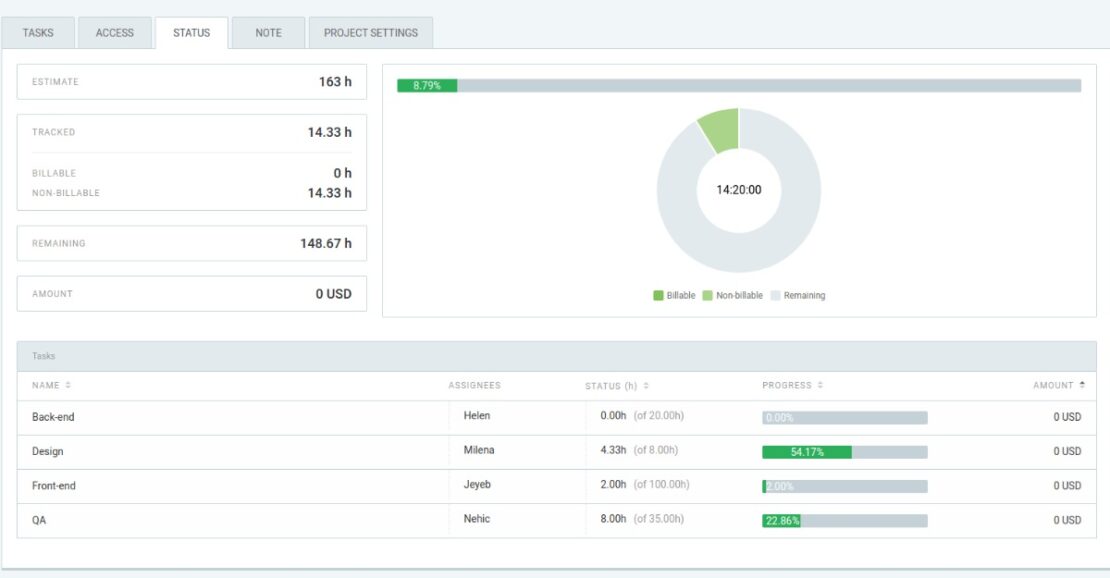
- Track in real time or log manually — use a timer when starting a task, or log time later if needed. You may also want to add notes or tags for context.
- Review your time weekly — use reports to spot trends. Then you’ll learn which clients take the most time or what tasks are eating into your day.

- Improve workflows — use your accounting time tracking data to restructure your week, adjust client billing, or reassign work across your team.
If you’re on the lookout for bookkeeping productivity tools, you can count on CAKE.com’s powerful trio — Clockify, Plaky, and Pumble.
With Clockify, you track time and monitor productivity. Plaky keeps your projects structured and tasks clearly assigned. Pumble ensures fast and seamless team communication.
To top it off, an interesting study about the power of digital accounting lists several benefits of using digital accounting tools, such as:
- Enhanced efficiency,
- Improved accuracy,
- Real-time financial insights,
- Remote access and collaboration, and
- Scalability.
#1: Use proven bookkeeper time tracking software
Here’s how to track time for bookkeeping with a tool like Clockify:
- Sign up for a free Clockify account — no credit card needed.
- Create a new project for each client or type of work.
- Start tracking time using one of these methods:
- Start/stop timer for real-time tracking,
- Manual entry if you forget to track live, or
- Drag-and-drop in calendar view for visual planning.
- Add details like task name, client, tags, and notes to keep entries organized.
- Set time estimates and deadlines — use estimates to plan how long tasks should take. Compare these to the actual hours logged — it’s a great practice for pricing and efficiency reviews.
- Set hourly rates — assign different billing rates to team members, clients, or projects. Mark tasks as billable or non-billable for clear invoicing.
- Use the mobile or desktop app to track time on the go, or install the browser extension to track from tools like Trello, Asana, or Google Docs.
- Review logged time in the timesheet or dashboard for daily and weekly overviews.
- Export reports to PDF, CSV, or Excel for billing or internal reviews.
With just a few clicks, you’ll have a clear picture of how your time is spent — and where it’s going. The video below explains Clockify time tracking in more detail:
#2: Employ integrations to manage clients without wasting time
Switching between clients is common in bookkeeping — and it’s where time loss often happens. Fortunately, Clockify makes it easy to solve this problem, as long as you:
- Label tasks so you don’t mix up time entries,
- Generate reports by client, project, or tag, and
- Integrate with tools like QuickBooks, Zoho, and more.
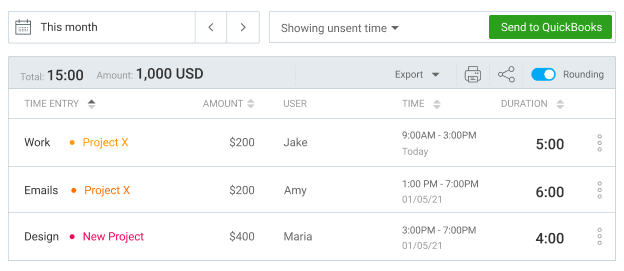
Finally, say NO to:
- Guesswork,
- Underbilling, and
- Double entries.
Such time tracking for bookkeeping provides smoother workflows and reduces time spent on tools.
Integrate Clockify with your tool
#3: Track consult calls for accurate client billing
Client calls can quickly eat up hours — and often go unbilled.
Proper client billing for bookkeepers is crucial, so here’s how to capture the calls in Clockify:
- Start the timer when the call begins,
- Add the client name and call topic in notes,
- Use tags like “consult,” “Q&A,” or “support,” and
- Stop the timer when the call ends.

Later, you can filter by tag or client and even invoice directly based on call time.
💡 CLOCKIFY PRO TIP
Businesses can greatly benefit from a time tracking practice, especially when their employees work away from the office:
#4: Use shared timesheets for transparent remote work
If your bookkeeping team is fully or partially remote, visibility and accountability matter more than ever.
Here’s how to manage time tracking remotely with ease:
- Set clear project tasks in Clockify so everyone knows what to log,
- Use shared office timesheets for transparency,
- Review weekly reports as a team — no micromanaging needed,
- Use time entries to balance workloads or reassign tasks, and
- Encourage team members to track time in real time, not after the fact.
Clockify makes remote collaboration feel structured and improves overall bookkeeping workflow management, even if your team is spread across time zones.
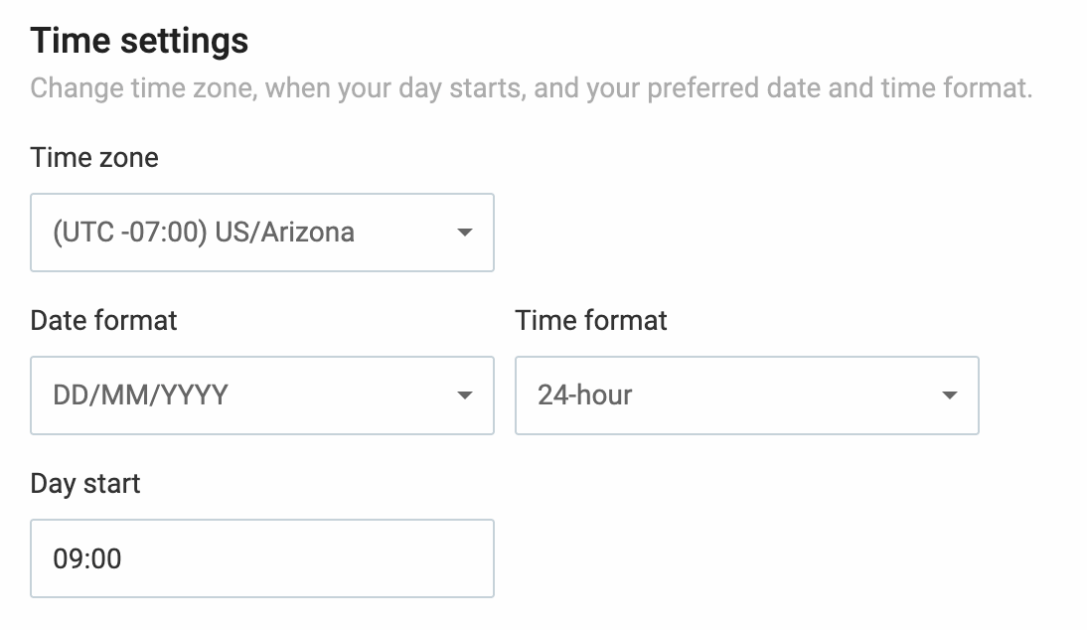
Our expert interlocutor, David Hern, explains that tracking time among remote teams is all about constructive feedback, and not oversight:

“Our firm is fully remote, and time visibility is critical. Even the Navy SEALs do a debrief after every mission, no matter how well or poorly it went. Why? Because that reflection is where growth happens. We treat our time data the same way. Every project deserves a debrief. Where did we spend our time? Did we over-deliver? Under-resource? Were we profitable?”
Similarly, Jackie Shaw also states that expectations have to be clear, but without micromanagement:

“When a bookkeeping team works remotely, it’s vital to maintain good communication. Make it standard practice that all time is tracked by job and by type of work. This keeps your reporting clean and helps you make better decisions about pricing, staffing, and where to focus your team’s energy.”
💡 CLOCKIFY PRO TIP
See how one of our clients successfully used Clockify to improve team efficiency while working remotely:
FAQs about bookkeeping time tracking
If you’re looking for more information on time tracking for bookkeeping, the following section may be helpful.
What is the best way to track time for accounting?
The best method to track time for accounting is to use software that integrates with your existing tools (such as QuickBooks), allows for project-based tracking, and generates detailed reports. This is where Clockify can help you.
How long should bookkeeping take per client?
Small businesses may take 5-10 hours per month, while larger clients or complex cases can take 15+ hours. One of the benefits of time tracking for bookkeeping is that it helps you learn your average.
Can Trello be used for accounting firms?
Yes, especially when paired with a time tracking tool like Clockify. With Clockify, you can track time per task card and export reports for billing.
Aside from Trello, Clockify also integrates seamlessly with popular accounting and project management software like QuickBooks, Zoho, and Asana. This lets you track time directly within your workflow.
So, you can log billable hours while managing tasks or client work — without switching between the apps. The result is:
- Faster invoicing,
- More accurate time reports, and
- Better project budgeting, all in one place.
What’s the difference between timekeeping and time booking in cost accounting?
Timekeeping is about recording the actual time employees spend at work — when they start, when they leave, and how many hours they’ve worked.
Time booking, on the other hand, involves recording how time is spent on specific jobs, projects, or tasks.
💡 CLOCKIFY PRO TIP
Learn all about the difference between financial and cost accounting, how to become a cost accountant, and more in this article:
Bookkeeping time tracking isn’t just for billing — it’s for growth
Tracking your time as a bookkeeper isn’t only about making sure you get paid — it’s about understanding your workflow, improving how you operate, and growing a more profitable, efficient business.
With a powerful tool like Clockify, you don’t just track hours — you turn them into actionable insights. You’ll know which clients take up the most time, where you’re most efficient, and how to better price your services.
And when it’s time to bill? Clockify makes invoice processing time fast and stress-free:
- Track all your billable hours by client or project using real-time timers or manual entry,
- Mark entries as billable (or non-billable) and set your hourly rate per project or team member,
- Go to the reports section and filter by client, project, or timeframe,
- Create invoice directly from the tracked data — no need to copy/paste into another system,
- Export your invoice as a PDF, CSV, or Excel, or send it straight to the client if you’re using a connected accounting tool, and
- Review unpaid invoices and track payment status — everything stays organized.
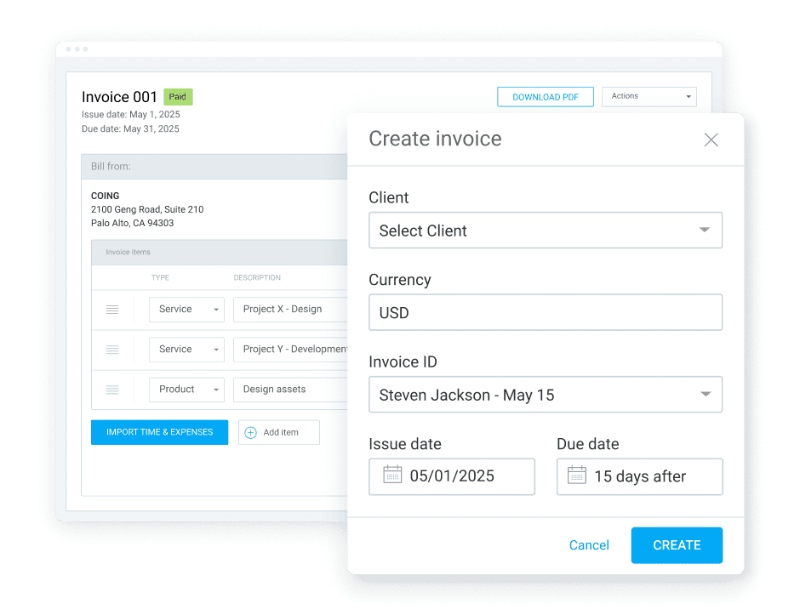
Whether you’re working independently or managing a team, Clockify helps you spend less time chasing invoices and more time doing meaningful work.
As an all-in-one solution for time tracking, vacation planning, scheduling, and reporting, Clockify also provides 24/7 customer support and a dedicated success representative for qualified users.
Ready to take control of your bookkeeping time with a budget-friendly app?

